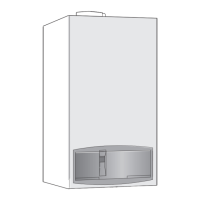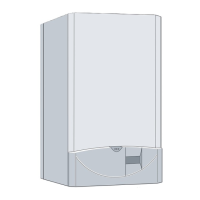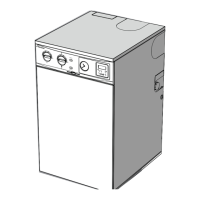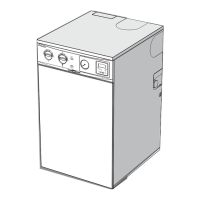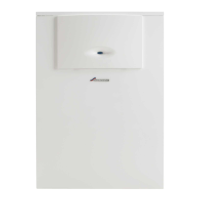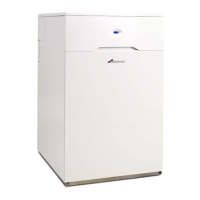6 720 610 576 GB (03.02)
Converting the appliance to different gas types
31
B Turn the temperature control until the display
shows 2. (= max. rated heat output).
The display and the button will flash.
Fig. 44
B Measure the CO
2
level.
B Prise off the seal on the gas flow restrictor.
B Adjust the gas flow restrictor (63) to obtain the CO
2
level given in Table 16. Refer to fig. 45.
Fig. 45
B Turn the temperature control anti-clockwise until
the display shows 1. (= min. rated heat output).
The display and the button will flash.
Fig. 46
B Measure the CO
2
level.
B Remove the seal from the gas valve adjusting screw
(64) and adjust the CO
2
level to the figure given in
Table 16 for min. rated heat output.
Fig. 47
B Recheck the levels at min. and max. rated heat output
and re-adjust if necessary.
B Turn the temperature control anti-clockwise as
far as the stop so that the display shows 0.
(= Normal operating mode).
The display and the button will flash.
B Press and hold the button until the display
shows [ ].
B Reset the temperature controls and to their
original positions.
The display will revert to the CH flow temperature.
B Remove testing probe from the flue gas testing point
(234) and refit sealing plug.
B Re-seal gas valve adjusting screw and gas flow
restrictor.
B Replace outer case and secure.
7.2 Testing combustion air/flue gas at
set heat output
7.2.1 Testing the O
2
or CO
2
level in the combus-
tion air
B Press and hold the button until the display
shows – –.
“Chimney sweep” mode is now active.
The button will light up and the display shows the
CH flow temperature.
Gas Type
CO
2
reading
at max.
rated heat
output
CO
2
reading
at min. rated
heat output
Natural gas type
G20
9.2 % 8.8 %
LPG G31
(propane)
10.8 % 10.5 %
Table 16
6 720 610 332-61.1O
63
6 720 610 332-64.1R
6 720 610 332-63.1O
i
By testing the O
2
or CO
2
level in the com-
bustion air the gas tightness of a type C
13
or C
33
flue system can be checked. The
O
2
level must not be less than 20,6 %.
The CO
2
level must not exceed 0,2 %.
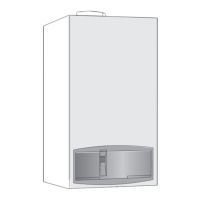
